#je suis urban architecture
Explore tagged Tumblr posts
Photo




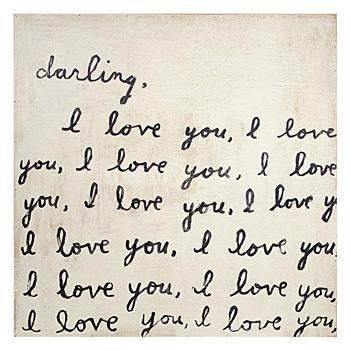

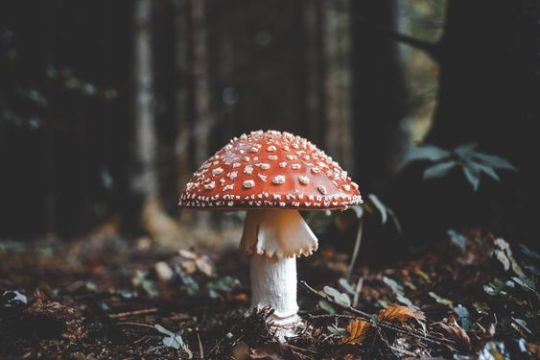
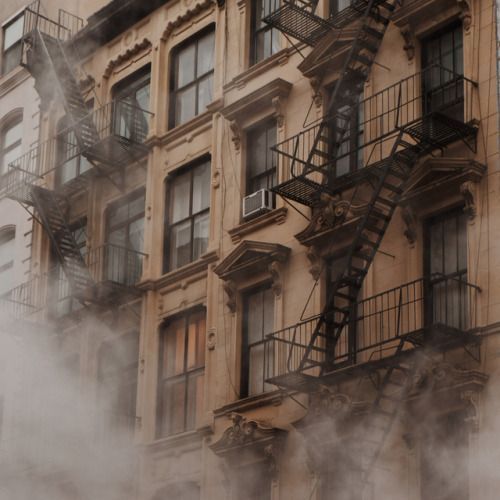

tagged by @savoy-brown-shoe and @queenofliqht to type in my name + core aesthetic on pinterest and make a moodboard. thank you!
i’m tagging @britneyshakespeare @stars-in-my-damn-eyes @idhrengondis @reshiiii and @mymainbloghere
6 notes
·
View notes
Photo

je m’appelle caroline, j’ai vingt-six ans et on me trouve sous le nom de wildtrophychild ou wtc_du_turfu sur les internets. ingénieure-architecte de formation, j’ai découvert le monde du tatouage il y a trois ans maintenant lors de mes études. travaillant une grande partie pendant ces dernières sur la sociologie urbaine, je me suis arrêtée sur deux sujets : la perception de la ville et le mouvement des corps dans la ville. ces deux thématiques ont été exploitées grâce à diverses méthodes, outils et technologies. c’est comme ça que le tatouage est arrivé (cf. le projet #regardelesmurs et morphisme)1. aujourd’hui, bien que ces projets universitaires soient aboutis, j’ai trouvé un réel intérêt et plaisir à les prolonger, à les étoffer, à les faire évoluer. le tatouage est devenu partie prenante de ma vie - j’exerce en tant qu’ingénieure en maîtrise d’oeuvre autant qu’en tant qu’artiste tatoueur. Le lien étroit qui me lie à ses deux professions est dorénavant nécessaire pour la suite…
1. https://issuu.com/krln/docs/portfolio_2019_v2_court
i’m caroline aka wildtrophychild or wtc_du_turfu on internet. i’m twenty-six, almost twenty-seven now. i graduated from an civil engineering school and an architecture school. i have discovered tattooing for three years now thanks to my studies. i worked a lot on urban sociology during those times - particularly on body mouvements and on sensorial perception in town. those both themas was developed through different methods, tools. and here we are with tattooing. now school is done but i would like to go on. i need both artistic hand and scientific hand to grow.
2 notes
·
View notes
Photo

⠀ ⏳ Que c'est loooooooOooOoooOooong ! Ce confinement commence à être long pour tout le monde, n'est-ce pas ? 🕑⠀ ⠀ On va pouvoir bientot retrouver mes proches ! Perso, j'ai hâte !!! Ma nonna, ma cousine, mes filleuls, mes amis... Je suis en manque d'eux !⠀ ⠀ Concernant cette photo, je vous avoue qu'elle date mais elle correspond parfaitement à l'état d'esprit actuel ! Allez, encore un peu de patience et de courage, c'est pour notre santé à tous ! 🏨⠀ ⠀ Puis, on voit que l'activité du pays reprend petit à petit 💪🏼 De mon coté, le boulot reprend mercredi ! 🤓 Tout cela est positif, mais restez prudent je vous en prie !! ⚠⠀ ⠀ ⠀ 👨👩👧👦 Prenez soin de vous et de vos proches !⠀ ⠀ ⠀ 🇧🇪 Belgique⠀ 🚆 Liege Guillemins⠀ 📷 #NikonD5300 + #35mm⠀ ⠀ ⠀ ⠀ ⠀ #liege #weloveliege #guillemins #visitliege #luik #lg #liegeguillemins #white #clock #monument #geometry #geometric #time #gare #lightroom #nikon #d5300 #35mm #lines #belgiumstreetstyle #city #architecture #cities #architecturelovers #sncb #belgique #belgium #liegetogether #urban (à Gare de Liège-Guillemins) https://www.instagram.com/p/B_79uBOJiwm/?igshid=jcjrlh83vcpa
#nikond5300#35mm#liege#weloveliege#guillemins#visitliege#luik#lg#liegeguillemins#white#clock#monument#geometry#geometric#time#gare#lightroom#nikon#d5300#lines#belgiumstreetstyle#city#architecture#cities#architecturelovers#sncb#belgique#belgium#liegetogether#urban
0 notes
Text
2017 - Le cul de Paname
Sur la carte, l’endroit ne semblait pas si éloigné. Mais quand en bout de piste le métro est sorti à l’air libre, coincé entre deux murs de béton portant la signature de tous les gamins du coin, j’ai réalisé que je me trouvais à la frontière du monde connu. Pour atteindre mon rendez-vous, j’ai traversé un condensé des pires tentatives architecturales de l’habitat urbain. C’est ici que s’expose la violence faites aux citoyens jusque sous leurs toits. Tout est laid, sale, déglingué et jamais un élu ne viendra reconnaître l’insulte. Arrivé à neuf heures, je suis passé à treize. Quatre minutes ont suffi pour liquider l’ancienne boîte de la cheffe, deux pour sa filiale qui m’employait.
2017 - The asshole of Paris
On the map, the place didn’t seem so far away. But when at the end of the track the subway went out in the open air, stuck between two concrete walls bearing the tags of all the local kids, I realized that I was at the border of the known world. To reach my appointment, I went through a condensed version of the worst architectural attempts in urban housing. This is where the violence perpetrated against citizens even under their roofs is exposed. Everything is ugly, dirty, wrecked, and a politician will never come to recognize the insult. I arrived at 9 a.m, and went to 1 p.m. Four minutes were enough to liquidate the former chief’s company, two minutes for her subsidiary who employed me.
9 notes
·
View notes
Photo

I've fallen in love with Limehouse Marina's neighbourhood, that I never visited before this weekend. Now is time to go back home... Tomorrow I'll be in the studio to prepare all your orders. 😉 / / / Je suis tombée amoureuse du quartier de Limehouse Marina, que je n'avais jamais visité auparavant. Hélas il est déjà temps de rentrer... Demain je serai de retour à l'atelier pour préparer toutes vos commandes !😉 #london #limehousemarina #marina #boats #cityscape #citylandscape #londres #londres2019 #london2019 #londonphotography #london_city_photo #london_enthusiast #london🇬🇧 #boat #bassin #architecture #urbanism #buildings #skyscrapers https://www.instagram.com/p/B152YPuCbpJ/?igshid=1cm80l997ylp0
#london#limehousemarina#marina#boats#cityscape#citylandscape#londres#londres2019#london2019#londonphotography#london_city_photo#london_enthusiast#london🇬🇧#boat#bassin#architecture#urbanism#buildings#skyscrapers
0 notes
Photo
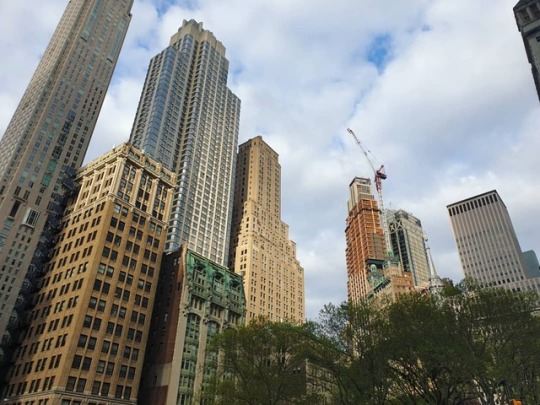
Ce que j'aime dans cette ville, c'est le mélange des genres. Le passé qui côtoie le présent. Les immeubles aux architectures très anciennes et, s'élevant derrière, des colosses de verre et d'acier. C'est la réflexion que je me fais sans cesse depuis que je suis arrivée. • #worldtradecenter #newyork #newyorkcity #nyc #ny #usa #unitedstatesofamerica #travel #citytrip #solotrip #voyages #voyage #holidays #vacances #spring #sunny #buildings #balade #city #urbain #urban #trip #traveler #travelgirl #architecture #modern #old #history (à World Trade Center) https://www.instagram.com/p/BxJAf-agBEb/?igshid=1k0heolly55lr
#worldtradecenter#newyork#newyorkcity#nyc#ny#usa#unitedstatesofamerica#travel#citytrip#solotrip#voyages#voyage#holidays#vacances#spring#sunny#buildings#balade#city#urbain#urban#trip#traveler#travelgirl#architecture#modern#old#history
0 notes
Photo

Quand on voyage, la pluie ça veut dire Musée ! Je suis donc au Museu de Arte de São Paulo, qui n'a pas de rez-de-chaussée ni de premier étage afin de conserver la vue de l'ancien Belvedere. On a l'impression que les gens qui passent en-dessous sont pris entre deux blocs de béton. Heureusement, de l'autre côté de la rue, le parc Trianon ajoute un peu de verdure à tout ça. C'est une petite jungle urbaine très dense, composée uniquement d'espèces végétales natives de la région. . #masp #saopaulo #paulista #museum #architecture #architecturelovers #city #urban #urbanism #forest #nature #parc #natureincity #green #brazil #ilovebrazil #explorebrazil #tourism #travel #cityscape #backpacker #concrete #exchangesemester #erasmus #intercambio (à MASP - Museu de Arte de São Paulo Assis Chateaubriand)
#explorebrazil#green#museum#saopaulo#urban#backpacker#erasmus#exchangesemester#concrete#architecture#forest#masp#city#paulista#parc#tourism#brazil#urbanism#nature#intercambio#architecturelovers#travel#ilovebrazil#cityscape#natureincity
0 notes
Text
Hyperallergic: A Kuwaiti Artist Contemplates the Failure of a Museum that Never Opened
Alia Farid, “3 Burqas” (2017) silkscreen print, 87 x 116 cm (all images courtesy of the artist and Galerie Imane Farès)
Galerie Imane Farès maintains a conspicuous and valuable niche within the Paris art scene, showcasing contemporary art from West Asia and southern Africa. Madame Farès strikes again with her show of artist-researcher Alia Farid, who is based in Kuwait (historically a gateway between East and West) and Puerto Rico. Farid’s enquiry-heavy works “act from the peripheral” (as she told me) and tilt towards the post-conceptual, postcolonial and autobiographical. Specifically, Between Dig and Display, her first show in Paris, scrutinizes the connotation of display within aniconic societies.
Generally, Farid works on the sensitive subject of unreconciled values. To address this issue she functions as cultural arbitrageur; creating acts of interpolation and assemblage, such as her “Monument to the Creative, Local, Informal Economy” (2008), a work of sculpture, video, and Islamic prayer rugs embroidered with images of Caribbean mosques.
Installation view of Between Dig and Display
In this show she uses the graphic look of conceptual art to fashion an installation that explores a museum’s failure. The installation, taken as a whole, probes a selection of material and documentation found in storage of the never-completed Kuwait National Museum. Bombed and plundered during the Iraqi invasion of 1990, the deserted, unfinished museum lost many of its historic and contemporary artifacts: Mesopotamian sculptures, slippers, coins, earthen pitchers, and such. Farid’s show draws from the archival ruins and records of this kitty: for example, with the image of a clay mother goddess (an image-concept that is problematic within Islamic fundamentalism) called “Untitled” (2017). It is essentially a 1985 record of two Assyrian goddess artifacts with severed limbs and head unearthed at Failaka Island — made poignant in light of recent ISIS beheadings. Such images contain a black and white rod set alongside the unearthed matter that provides the reader with a sense of scale. This rod has been recreated by the artist and placed throughout the installation to good effect, recalling to mind the bâton that the insouciant French conceptual artist André Cadere ubiquitously utilized in the 1970s.
Alia Farid, “Untitled” (2017) 80 x 95 cm
The conceptual point of Between Dig and Display, it seems to me, is that culture is born out of exchanges and thrives on perceived differences. So a Kuwaiti national culture (or any national culture) is a self-contradiction. On the other hand, multiculturalism is a redundant pleonasm. The end of any culture lies in self-obsession and isolationism. So living cultures always require something between (and beyond) these two polar ideals.
Farid’s betweenness stems from her working in the gap between art, architecture, and urban anthropology — with an eye for demonstrating how informal networks are forced to make up for lack of formal structures. Thus, her work, as she is herself, is much harder to pin down, and it and she join in what Brazilian anthropologist Eduardo Viveiros de Castro calls in Cannibal Metaphysics the “permanent exercise in the decolonization of thought.”
Details ofBetween Dig and Display (below) photograph of where the artist lived during her childhood, (architect Georges Candilis), 50 x 56 cm ; (above) cotton bag with ceramic reproduction of the artist’s toy
Born of a Puerto Rican architect mother and Kuwaiti architect father in 1985, Farid obtained a Master in Visual Studies degree from M.I.T. and one in museum studies from the Museum of Contemporary Art, Barcelona. So, her cerebral chops are unimpeachable. But I also really like the way she boldly mixes in narcissism-free autobiographical material here — like the white, cotton net-bag embracing a pale ceramic reproduction of Gumby, one of the artist’s childhood toys. This is hung over a photograph of where she lived in Kuwait during her childhood. The addition of such personal detail woven seamlessly into the installation sets up a situation in which the mind vacillates between state narratives based on objective records and self-portraiture. Such vacillation opens up her life to unexpected, and novel creative potencies and territories.
Her show assembles disparate things and images, yet hangs together beautifully: unified in predominantly post-conceptual palette of black, white and gray. This unity of tone allows the artist to mix boldly ancient artifacts and new things, illustrating the ongoing mêlée within the social fabric of Kuwait. One of the best examples of this fracas is the hydra-spouted “Porcelain Teapot” (2017) painted with flowers and images of a mother and her child, with the mother’s face excluded. This exclusion alludes to the history of Persian miniature painting, where in order to sidestep the prohibition against actually depicting Mohammed, artists in Muslim societies sometimes showed him with his face blank. This way, it could be claimed that they never actually drew Mohammed — only his clothes. In that history we also find faceless Mohammeds who originally had faces which were later scratched out. This restriction on showing face was the preference of one of Farid’s female relatives, whose face has been removed on her request from “Untitled” (2017), a family photograph placed next to “Porcelain Teapot” that depicts Farid’s father having his hair shorn. Another semiotically rich work is the limestone sculpture “Lovely Gift from Blessed Land” (2017) that looks like a gas can, but is in fact a replica of a portable container of holy water. Also there are multiple versions of the silkscreen “3 Burqas” (2017) that haunts and amuses. The menacing but madcap imagery of free floating burqas struck something deep in me that may have to do with my juvenile passion for Mad magazine and recent events around Je suis Charlie.
Alia Farid, “”Porcelain Teapot” (2017) unique porcelain teapot
In the basement gallery I dipped into “Theatre of Operations (The Gulf War seen from Puerto Rico)” (2017) (excerpted here), a gurgling and wobbling four-hour video of unadulterated footage from 1990 and 1991 — the period when Farid’s family escaped the Gulf War in Kuwait and fled to Puerto Rico. In Puerto Rico, news reporters closely followed the family’s lives and the effect the vertiginous whirl of war had on them, turning their intense experiences? into a proto-reality TV show something along the lines of An American Family. This spin of media attention paralleled the media attention that the Gulf War itself received: a war waged by coalition forces from 35 nations led by the United States against Iraq in response to Iraq’s invasion and annexation of Kuwait. Indeed the artist cited to me as influence on her work, Jean Baudrillard’s book of essays The Gulf War Did Not Take Place which makes the point that media representations made it hard to distinguish between the experience of what truly happened and its stylized simulacra. Excellent. The video also contains a segment where a Puerto Rican reporter goes to Kuwait after the war to interview relatives of the artist who stayed in the country, and interviewed Puerto Rican soldiers who participated in the liberation of Kuwait.
Alia Farid, “Untitled” (2017) mounted re-touched photograph, 29.7×42 cm
For Farid, the Gulf War changed the way the world absorbed images, and her video appropriation conveys the complexity of Western Asia’s political landscape from the vantage point of Puerto Rico, in its own subservient position to the United States. But even though the destruction of war is foregrounded, what I really appreciated about her show is how it pushes back against a lack of concern for heritage, a lack which is the salient feature of both war and neoliberal consumerism worldwide. The exhibition also suggests to me that the visibility of what can be desired, demanded or attended to, is arbitrarily autobiographical, and thus potentially meaningless to others. But, on the other hand, by publicly injecting her story into two national histories, she gives those nations additional meaning — just as they give meaning to her art. Finally, Farid’s work suggests that what the world requires now is not national cultures but cultured nations.
Between Dig and Display, continues at Galerie Imane Farès (41, rue Mazarine, 6th arrondissement) through September 18 (except the month of August when the gallery will be closed).
The post A Kuwaiti Artist Contemplates the Failure of a Museum that Never Opened appeared first on Hyperallergic.
from Hyperallergic http://ift.tt/2tlJa51 via IFTTT
0 notes
Text
Sonic Protest 2016 Part I
for The Attic Magazine
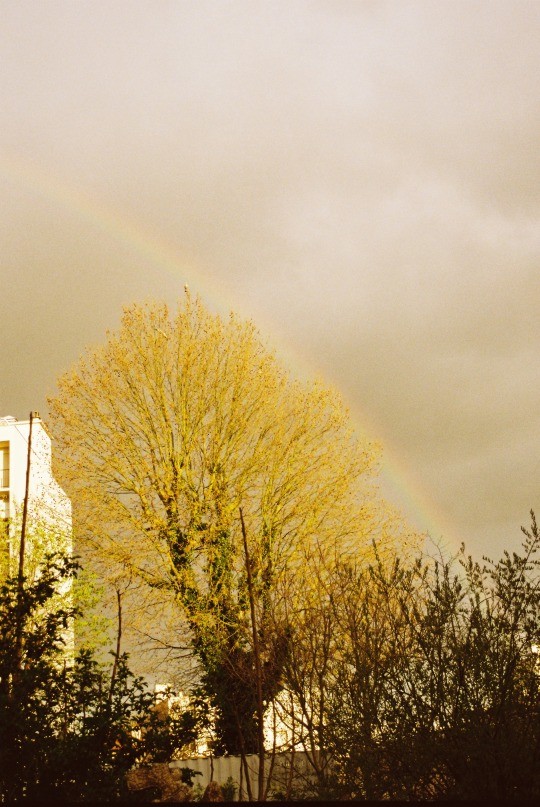
Prologue - Un temps tendu
''The atmosphere is quite heavy right now''; those were the first words my friend said to me, coming to pick me up from Nationale. Initially, I thought she was referring to her, as she recently moved in with her boyfriend, then she went on ''...you know, with the riots and everything''. I left Paris on November 16th, the Monday right after the shootings. I had been living there for over 5 years. This was my longest trip back to the city after the recent tragedy. It's strange how the events have permanently changed the city; in a way, you can't think of Paris anymore without terrorism in mind, just like you can't picture New York City without 9/11 anymore. I still recall the day right after the attacks - the panic and confusion that ensued. I was alone in my friend's studio and she told me that the people on the news advised everyone to stay indoors. I started to get claustrophobic towards the evening and decided to venture outside for some food. To my surprise, things seemed strikingly normal - people were chatting outside the cafes, taking the metro, going to the supermarket. Life went on. Six months later, it felt like the city was back to its usual pace and the November 13th tragedy was some distant memory. Only, unlike the Charlie Hebdo shootings the previous year that after many weeks of seeing the support message Je suis Charlie in literally every newspaper, bar or Facebook page, things were still tense. Place de la Republique remains the Gordian knot of an intricate conflict web that the authorities still can't seem to be able to contain. It's a big open space that could fill up quite quickly, located in the middle of several tiny streets. Republique has become that spot that illustrates the social clash between people who come to protest, skaters, and youngsters from the banlieue coming over from Bastille for a night out, yuppies from Le Marais, cops and homeless people. I remember the Sunday after the attacks; I took the metro to Republique. As the train stopped, there were people running into the train scared and crying, shouting not to get out. On a random night back in March, one of the exits was blocked and there were ambulances and police cars outside. And now, the riots. When I first moved to Paris, back in September 2010, the friend who hosted me suggested I should go to a manif. She described it like this somewhat entertaining activity, where the streets get blocked and people march drinking, singing and chanting slogans. And, of course, a typically French custom, that would help me understand the culture better. At the time, they were protesting against the new retirement age. And yes, it did feel like a big street party. But now riots have changed; there is tear gas and an alarming amount of police violence. I heard rumors about the things going on at Republique, how people started a sort of occupy movement and have taken over the place. My festival-related trips didn't bring me near the area until this particular Sunday, April 9th, when I was stuck in the metro with the doors closed for about 15 minutes for a security clearance at Republique. A big protest was scheduled that night, roads blocked, bus and traffic deviated. Having missed the last train, I got out on the square in search of a night bus, not really knowing what to expect. As I emerged from to the over ground, it felt like I was transported in a sort of Mad Max inspired reality, with slogans, street musicians, street vendors and even an urban garden improvised out of plastic bottles. They have been protesting for days against the new labor law, which would erase some essential advantages of the Front Populaire and their radical reform in 1936, making the 40-hour work week no longer compulsory. It was a tense time indeed.
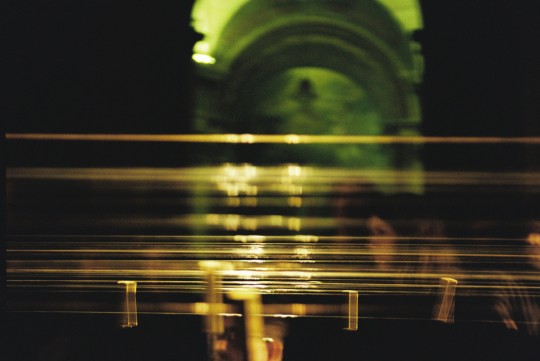
Instant Chavires' Day Out
For me, springtime in Paris was spread around the three major underground and experimental music festivals that accompanied the changing of the seasons: Presences électronique in March, Sonic Protest in April and Villette Sonique in May. Attending these events or simply looking at the line-ups and making plans were a yearly rite of passage, fully part of my daily life. It was just like a series of solstice rituals, which happened organically. This year was the first time the festival was not just something in my life, but an event I built my calendar around. Going to Paris specifically for the festival operated a shift in my perspective, making the entire trip an event. Given the whole social context this year, the festival started to gain a series of new political connotations. Or, I was perhaps starting to decipher new metaphors within the music. Even the name, Sonic Protest, felt like a sort of slogan. Within the so-called 'experimental spring' of Parisian festivals, Sonic Protest is probably the most dashingly diverse. Framed by Presences électronique, GRM 's showcase of electro acoustic, experimental and modern composition, and Vilette Sonique, on the more pop side of the underground spectrum, Sonic Protest is a very unique endeavor both in terms of programming and funding. The festival has been around for 13 years, with Arnaud Rivière and Francq de Quengo as programmers. For the connoisseurs, Arnaud Rivière is also the guy behind the cult venue Les Instants Chavirés in Montreuil, a DIY space for experimental music that has been around for over 20 years. Although Instants Chavirés is partially funded by the Mairie de Montreuil, Sonic Protest is mostly a self-financed affair. The diverse programming at Les Instants (internationally, Cafe Oto in London and OCCII in Amsterdam could be considered kindred spirits) blending noise, ambient, free jazz, no wave, weird folk and experimental techno among its genres (last year Les Instants saw Black Zone Myth Chant, a High Wolf psychedelic side project and LIES artist Lowjack play the same bill, for example).
This sort of hunger for new and exciting music is at the core of the festival. However, unlike Les Instants, which can feel pretty packed if there are 100 people inside, Sonic Protest has the luxury of playing with bigger venues. It almost feels like Sonic Protest is Instants' field day - get out the big guns and let's have some fun! The festival stretched out for two weeks this year, with the main series of 8 concerts in Paris, followed by events in other cities in France and Belgium. A sound art exhibition and a series of film screenings and conferences were also part of the program. I could only attend 4 shows this year, but they were the most impressive, core events of this noisy shindig.
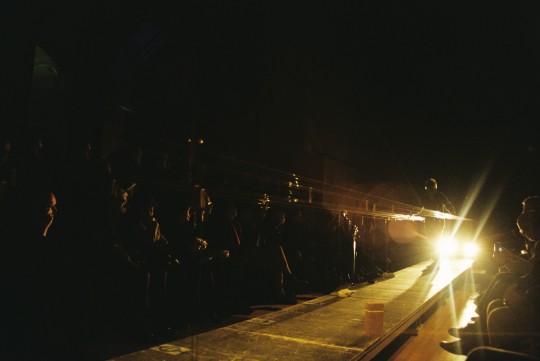
Modern Elegies
I arrived in Paris Wednesday morning, after a sleepless night and a 6 am flight to Beauvais Tille, also known as the bus stop airport. Porte Maillot, with its shuttles and cheap bus rides, brimming with immigrants and Asian backpackers was a much too painful déjà-vu. Only this time I wasn't headed to my 5th floor walk up with a terrace in Clichy, but to and a couple of nights on an air mattress in my friend's new apartment, still filled with moving boxes and lingering paint smell. Getting accustomed to the 10-degree temperature drop from Bucharest, all I could think about was sleep. As I rushed towards the already familiar sight of L'Église Saint Merry, this catholic church by the Kandisnky fountain, right near IRCAM and Centre Pompidou, I was already back into my grumpy Paris self, cursing the crowds at Les Halles and sporting a permanent frown. Last time I was there back on a cold night in September, when John Butcher did a solo and Eliane Radigue presented one of her new acoustic, orchestra pieces. There are three things you need to know about this church - it's extremely cold, the chairs are notoriously uncomfortable and the sound is always challenging because of its architecture. For the first time, I felt like Saint Merry found the perfect performance for the space in Ellen Fullman's Long String Instrument. I first saw a movie of this piece in a show at Le Plateau and I remember being greatly impressed by the physicality of the instrument. Now, it was a question of scale - stepping into the empty space, with only a couple of people from the festival staff shuffling around preparing for the big night, the sight of this 30 meter long catwalk surrounded by strings that took over the entire nave was quite breathtaking. The entire installation was wrapped in traffic tape, an extra security measure for this robust yet delicate instrument. The resonating strings were held together by 15 large 35kg sand bags on each side.
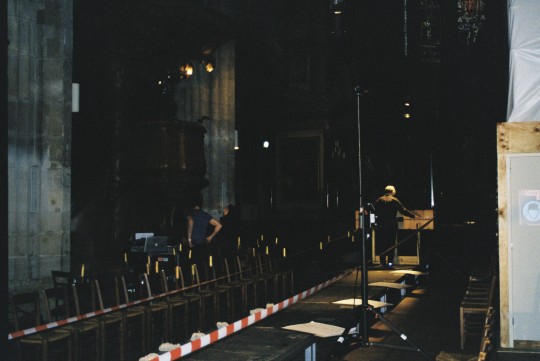
A fragile silhouette, not much taller than 1.60m, dressed in a nondescript black windbreaker and sneakers, was walking among the strings, making final adjustments. Composer Ellen Fullman was a particularly discreet presence, with her short white hair, tiny glasses and a gaze suggesting perpetual curiosity. Part of the wave of great minimalists, influenced by Alvin Lucier and Harry Partch, she is a lesser-known figure among the average contemporary classic music fan. Just like Eliane Radigue in France, her incredibly innovative work has been marginalized until the last decade. This was to be her first performance in France and it was no surprise that Eliane Radigue, the other great lady of deep drones, was there to support her. The two together, chatting, made for an endearing sight and an important page in the history of modern music. Later, at the communal table, I somehow ended up at the same end of the table as them; it was surprising how everyone from the staff was just going on about their dinner, while the two ladies were wrapped up in their own private bubble, sharing ideas about each other's work. The one thing that caught my ear was Ellen asking Eliane about her notation system, to which she replied that she didn't have one and had to explain to each performer how to play her pieces. Returning to the church, I could see all the intricate series of numbers scattered across the wooden walkway, from sheets that looked like scores to numbers marked near the resonating wood boxes or the stones that were weighing down metallic clips onto the strings. I didn't know if I was looking at a Carl Andre/ Daniel Buren hybrid piece of sculpture or at a gigantic, gutted prepared piano.
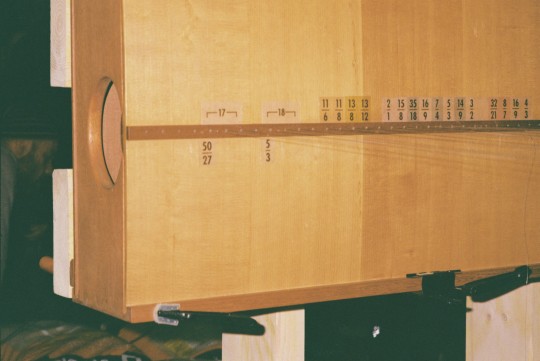
Soon, the spots behind the seats and those between the rows started to fill; some younger kids were even sitting on the freezing church floor in front of the chairs. We were gearing up for a sold out evening, which, given Saint Merry's capacity, meant around 600 people. Then, the large stage lights went on; the tape was cut. The audience was growing restless in anticipation. Ellen took to the stage and started gently tapping on the strings at the left end. The beginning was very low and subtle, certainly not enough to drown her out. My angry glaring certainly didn't help. Then, something changed. The whispering stopped. Everything pretty much stopped, for that matter, as Ellen's piece was slowly growing bigger and more resonant. Even the photographer stopped taking photos, as if embarrassed by the sound of his camera disturbing the silence of the piece. It was as if the entire audience was swept by this large wave of emotion, drowning everything in its way. The metallic drones grew deeper and deeper as Ellen was walking across the platform, as if in a trance, like a shaman trying to control the fire of her vision. It sure was a strong beast to tame, this grandiose, unusual instrument.
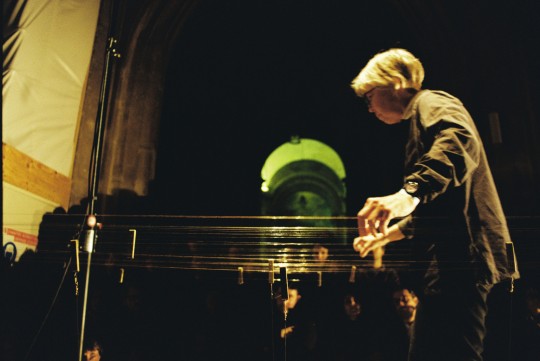
If in the first couple of minutes people were still holding out their phones, documenting this strange sight, they quickly started to let go and patiently listen to the slow progression of the music. I don't think I ever heard the church audience as quiet as that night. There was a sort of collective concentration, a group focus that felt almost electric. The drones started getting deeper and deeper, evoking dark visions that were slowly growing darker. I didn't even dare look at Ellen, although her small but stern fingers kept moving across the strings, barely 20 cm away from me at times. She was looking down, carefully following her notes. The atmosphere started to get darker; you could sense the thick layer of emotions she conjured. Everyone around me was frozen, possessed. About five seats down from me on the opposite row there was this blonde woman, ducking between the passageways left between the seats. She was on her knees, looking up at Ellen, fist clenched under her chin. Her eyes were wide and moist and mouth vaguely agape. The composer kept her slow pacing up and down the catwalk and this lady's stare was following her every move. The next time I looked at her, I could see the black smudging of her eyeliner giving her a hazy look. As the piece progressed, I was more and more fascinated by this woman, whose mascara started dripping by now. It's as if she was expressing a sort of ancestral suffering awakened by the music, in a sort of Madonna pose bearing all of our pain. Maybe she has just recently broke up with her boyfriend or was going to some other very personal drama; either way, the music sure struck a chord with her and there she was, full-on crying for all of us dry of tears. It was such a touching portrayal of this large, sad, beautiful music. By the end of the first piece, I must have seen at least three people barely holding back their tears. Then, the music stopped. It took about 45 seconds for the last chords to finish resonating before the church broke into a frenetic applause. It was a cathartic moment, as if a heavy lead blanket had been suddenly lifted. I believe that if she kept going for even a few more minutes, we might have all ended up weeping.

Visibility uncomfortable by the overly enthused round of applause, Ellen muttered a quick 'Thank you' and rushed to the middle of the walkway to turn on a motor for her next piece. This was a much shorter and lighter effort, the constant movement on the string giving it an almost jolly undertone. Again, an explosion of applause and ''Bravos!''s followed. I think the composer was slightly startled by this utterly warm welcome and slightly annoyed for having her set interrupted. She then placed herself at the left end of the catwalk, where the resonating boxes and loose ends of the strings were. She started rapidly pulling on them, building up an alert pace of higher tonalities. At first it looked like some kitten playing with the extra string hanging from the knitting basket and we weren’t even sure if she was playing or simply started undoing the installation. This roughly 5 minute piece has the much needed playfulness after the first long meditation. It almost felt like a hopeful glimmer of light that would help us get out of the dark world she has previously ushered us into. Things moved quite quickly after that – the staff started moving the chairs, uncovering the sand underbelly holding together the whole apparatus. The transition was probably a little too abrupt but they were already behind schedule and there was no time to lose. I felt like even if that was the only thing I got to hear during the festival, I would go home happy. As I went outside for some air, I almost couldn't fathom coming back and listening to more music. Ellen's piece was just that overwhelming. Even if you didn't enjoy it, it still had quite the impact. The whole experience was quite humbling.

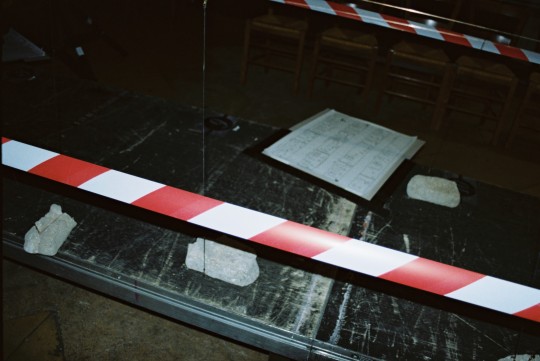
I heard the sound engineer talk to some other guy afterwards describing it as ''heavy''. At the same time, especially after that first taste of returning to Paris and all the turbulence that ensued, it felt like the most appropriate thing one could listen to in those messy times; something that played on our fears and pain, exposing it into the music. Ellen's elegy had strangely specific undertones in her universality.
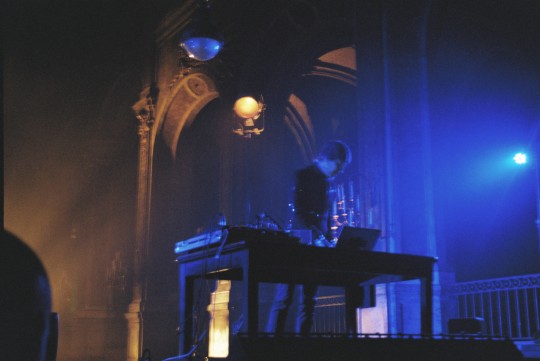
End of the nave
Going back inside, I arrived in the midst of the usual Saint Merry concert sight: people gathered around the bar side, talking quite loudly, a couple of curious spectators by the improvised record store booth and a few dozens of people standing, crowding in front of the altar stage. On stage, a guy in mid-thirties, with a small beard and fisherman's beanie was playing medieval-inspired laments on a violin drenched in electronics. He looked like the wandering bard you would read about in fairy tales. Yet his approach was somewhat oblique, wearing his pop and chanson heritage on his sleeve. While most of the songs were slightly upbeat and even had dance potential, there was something utterly sad in the air. I knew my mind was still tangled up in Ellen's strings and for some reason couldn't commit to the young bard's tales. Even though they felt like songs from a dead king's banquet, there was a celebratory element that felt slightly inappropriate. Given another context, I would have probably been more inclined to delve into Sourdure's pagan folk. It was probably just my overall tiredness or the length of his set, but the evening was just a little too dense. There was a moment when he paused, put down his violin and started addressing the audience; he told us that in medieval times, there was this custom of people from the village to go from house to house asking for food, while singing songs. Then he shared an acapella version of one of those songs. In the dimly lit church, I felt transported into a caravaggesque time where everything happened in dark little room by candlelight. It seemed like he conjured the entire magic of his set in this stripped-down 3-minute song. Basinski's set took me by surprise. This was the moment we've all been waiting for: hearing the new piece by the tape drone master made for a highly anticipated set.
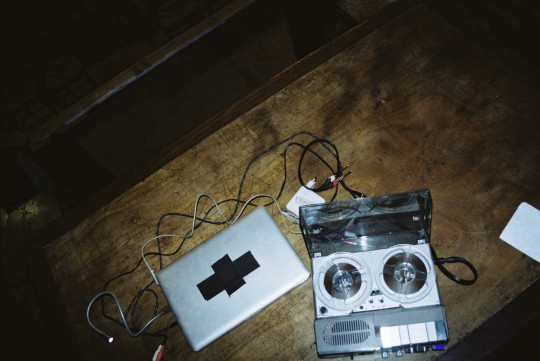
I managed to shimmy my way up front, to feel those loops right in my guts by the subwoofer. The feeling was quite intense, giving the enveloping effect I was hoping for. Only the cold marble of the church didn't make for a very comfortable listening spot. Some kids around me were sitting with their eyes closed, in a semi-conscious state, caught up in William's daydream. As I rose from my nosebleed seat, the sound started quickly diminishing, losing most of its low-frequency intensity. Instead, you could hear this dark ambient music reflecting on the tall church walls. It seemed that the crowd around the stage grew even bigger. Some people pulled up chairs to the side and were listening patiently. The music felt like a soundtrack for all these strange audience members, elongating their necks trying to catch a glimpse of Basinski or standing on chairs in order to take a good photo. And he was just slowly moving into the blue light, wrapped up in his sequin jacket, sporting an absent smile. It reflected the light beautifully; for a moment I even thought his jacket was actually made out of LED lights. I spent the end of his set towards the very end of the nave, hearing all the resonant frequencies break onto the walls. His piece had the classic beauty of his previous work, the same drawn-out elegant sadness, yet somehow I couldn't fully enjoy it. Maybe it was because all of the hype created; I'm sure I wasn't the only 20-something who came to the festival especially to see him. They say it's not good to meet your mentors; in William's case, the live experience felt a bit underwhelming. Not that his music didn't make for a very touching experience, especially in the gorgeous space of Saint Merry, yet I felt like something was missing: his sadness was too overtly beautiful yet light, almost sporting a pop sheen. Maybe Basinski finally figured out how to emulate Eno's Music for Airports after all. Which was one of the things I loved about it in the first place – this baroque, aestheticized sense of suffering. However, it didn't hit me in the gut this time. Ellen's piece felt raw, almost brutal in comparison. The audience scattered quickly as the show ended, either running for the last metro or hoping for William's reappearance for a selfie or an autograph. While the engineers were packing up his setup, one tiny silhouette was contemplating the space, empty once again. It was Ellen Fullman, that somehow went unnoticed by the remaining groupies, still chasing after the glittered Basinski unicorn. I wanted to talk to her, but she seemed too deep in her own thoughts to be disturbed. This great tiny lady was surely brewing up another storm.
0 notes